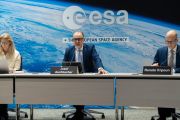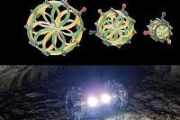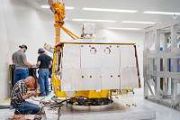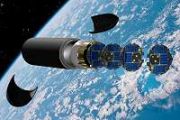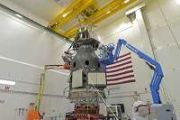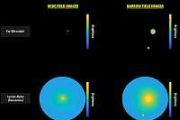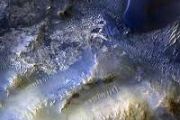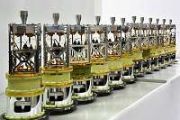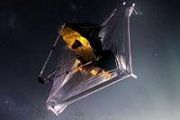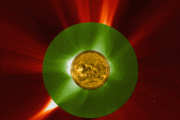
Copernical Team
CACI announces demonstration of optical intersatellite links in low earth orbit
 CACI International Inc (NYSE: CACI) reports it has successfully demonstrated space to space optical communications links in low earth orbit (LEO) in partnership with the Defense Advanced Research Projects Agency (DARPA) and the Space Development Agency (SDA) as part of the Mandrake II program.
Mandrake II is a joint risk-reduction program with DARPA, SDA and the Air Force Research Laborato
CACI International Inc (NYSE: CACI) reports it has successfully demonstrated space to space optical communications links in low earth orbit (LEO) in partnership with the Defense Advanced Research Projects Agency (DARPA) and the Space Development Agency (SDA) as part of the Mandrake II program.
Mandrake II is a joint risk-reduction program with DARPA, SDA and the Air Force Research Laborato Australian Uni and SSC sign MoU to strengthen space capabilities in Australia and Sweden
 Western Sydney University's International Centre for Neuromorphic Systems (ICNS) has signed a Memorandum of Understanding (MoU) with the Swedish Space Corporation (SSC) in a move to formalise and strengthen international space observation research partnerships and collaborations.
The MoU will facilitate the sharing of research data and analytics, and the co-location of vital space observat
Western Sydney University's International Centre for Neuromorphic Systems (ICNS) has signed a Memorandum of Understanding (MoU) with the Swedish Space Corporation (SSC) in a move to formalise and strengthen international space observation research partnerships and collaborations.
The MoU will facilitate the sharing of research data and analytics, and the co-location of vital space observat The European Innovation Council supports E.T. PACK-Fly, a project to mitigate space debris
 The E.T.PACK-Fly consortium, coordinated by the Universidad Carlos III de Madrid (UC3M) and made up of the University of Padova, the Technical University of Dresden (TU Dresden), the Spanish company SENER Aeroespacial and the German start-up Rocket Factory Augsburg (RFA), has received euro 2.5 million from the European Innovation Council (EIC) to develop a device based on a space tether to deor
The E.T.PACK-Fly consortium, coordinated by the Universidad Carlos III de Madrid (UC3M) and made up of the University of Padova, the Technical University of Dresden (TU Dresden), the Spanish company SENER Aeroespacial and the German start-up Rocket Factory Augsburg (RFA), has received euro 2.5 million from the European Innovation Council (EIC) to develop a device based on a space tether to deor Preparation for LizzieSat-1 Mission continues as NASA customer completes important milestone
 Sidus Space, Inc. (NASDAQ:SIDU), a Space-as-a-Service satellite company focused on commercial satellite design, manufacture, launch, and data collection, has announced that the NASA team successfully completed their Preliminary Design Review (PDR) milestone on May 6th, 2022, to support the ASTRA project, selected under NASA's Project Polaris.
In support of NASA's Autonomous Satellite Techn
Sidus Space, Inc. (NASDAQ:SIDU), a Space-as-a-Service satellite company focused on commercial satellite design, manufacture, launch, and data collection, has announced that the NASA team successfully completed their Preliminary Design Review (PDR) milestone on May 6th, 2022, to support the ASTRA project, selected under NASA's Project Polaris.
In support of NASA's Autonomous Satellite Techn DARPA pursues tactical-grade clock that maintains precision over time
Seeing through the fog-pinpointing young stars and their protoplanetary disks
 Imagine walking through a dense, hazy fog in the middle of the night, seeing patches of light from cars and towns shimmering in the distance. It's nearly impossible to tell if the lights are deep in the fog or beyond it. Astronomers trying to find young stars face a similar problem: the light from stars they're hunting is shimmering through great big regions of hazy gas and dust in space, called
Imagine walking through a dense, hazy fog in the middle of the night, seeing patches of light from cars and towns shimmering in the distance. It's nearly impossible to tell if the lights are deep in the fog or beyond it. Astronomers trying to find young stars face a similar problem: the light from stars they're hunting is shimmering through great big regions of hazy gas and dust in space, called Mars' emitted energy and seasonal energy imbalance
 A seasonal imbalance in the amount of solar energy absorbed and released by the planet Mars is a likely cause of the dust storms that have long intrigued observers, a team of researchers reports.
Mars' extreme imbalance in energy budget (a term referring to the measurement of solar energy a planet takes in from the sun then releases as heat) was documented by University of Houston research
A seasonal imbalance in the amount of solar energy absorbed and released by the planet Mars is a likely cause of the dust storms that have long intrigued observers, a team of researchers reports.
Mars' extreme imbalance in energy budget (a term referring to the measurement of solar energy a planet takes in from the sun then releases as heat) was documented by University of Houston research A SAM Methane Experiment Between Drives Sols 3476-3477
 Curiosity continues to navigate challenging terrain. The drive executed over the weekend moved us 8 m from our previous location. Prior to the weekend drive, we completed contact science with APXS and MAHLI on targets "Pedra Pintada" and "San Pedro," the latter of which was brushed with the Dust Removal Tool (DRT) to remove thin airfall dust that was coating the surface of the rock face. Dust is
Curiosity continues to navigate challenging terrain. The drive executed over the weekend moved us 8 m from our previous location. Prior to the weekend drive, we completed contact science with APXS and MAHLI on targets "Pedra Pintada" and "San Pedro," the latter of which was brushed with the Dust Removal Tool (DRT) to remove thin airfall dust that was coating the surface of the rock face. Dust is Rocket engine exhaust pollution extends high into Earth's atmosphere
 Reusable space technology has led to a rise in space transportation at a lower cost, as popularized by commercial spaceflights of companies like SpaceX and Virgin Galactic. What is poorly understood, however, is rockets' propulsion emissions creating significant heating and compositional changes in the atmosphere.
In Physics of Fluids, by AIP Publishing, researchers from the University of
Reusable space technology has led to a rise in space transportation at a lower cost, as popularized by commercial spaceflights of companies like SpaceX and Virgin Galactic. What is poorly understood, however, is rockets' propulsion emissions creating significant heating and compositional changes in the atmosphere.
In Physics of Fluids, by AIP Publishing, researchers from the University of NASA Seeks Input on Moon to Mars Objectives, Comments Due May 31
 As NASA moves forward with plans to send astronauts to the Moon under Artemis missions to prepare for human exploration of Mars, the agency is calling on U.S. industry, academia, international communities, and other stakeholders to provide input on its deep space exploration objectives.
NASA released a draft set of high-level objectives Tuesday, May 17, identifying 50 points falling under
As NASA moves forward with plans to send astronauts to the Moon under Artemis missions to prepare for human exploration of Mars, the agency is calling on U.S. industry, academia, international communities, and other stakeholders to provide input on its deep space exploration objectives.
NASA released a draft set of high-level objectives Tuesday, May 17, identifying 50 points falling under 
